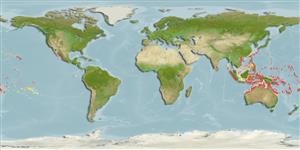Common names from other countries
>
Blenniiformes (Blennies) >
Blenniidae (Combtooth blennies) > Blenniinae
Etymology: Meiacanthus: Greek, meion = less = lessen + Greek, akantha = thorn (Ref. 45335).
More on author: Günther.
Environment: milieu / climate zone / depth range / distribution range
Ökologie
seewasser riff-verbunden; tiefenbereich 0 - 30 m (Ref. 128797). Tropical; 30°N - 24°S
Western Pacific: Bali and the Philippines east to Samoa, north to Ryukyu Islands, south to Rowley Shoals, the southern Great Barrier Reef, and New Caledonia; throughout Micronesia. Replaced by the uniformly yellow species ovalauensis in Fiji, and by Meiacanthus tongaensis in Tonga (Ref. 37816).
Size / Gewicht / Alter
Maturity: Lm ? range ? - ? cm
Max length : 11.0 cm TL Männchen/unbestimmt; (Ref. 9710)
Rückenflossenstacheln (insgesamt) : 4; Rückenflossenweichstrahlen (insgesamt) : 25 - 28; Afterflossenstacheln: 2; Afterflossenweichstrahlen: 15 - 18. Identified by the blue-edged diagonal black line from the eye and yellow dorsal fin or back. Adults have long filaments on the caudal fin tips; length without filaments (Ref. 48636).
Adults are found solitary or in pairs (Ref. 90102) in lagoon and seaward reefs below the surge zone to 30 m depth (Ref. 9710). A common species, often seen along slopes and drop-offs, adults sometimes in small groups (Ref. 48636). Feed on zooplankton and also on small benthic invertebrates. Inoffensive, but immune from predation (Ref. 9710). Oviparous. Eggs are demersal and adhesive (Ref. 205), and are attached to the substrate via a filamentous, adhesive pad or pedestal (Ref. 94114). Larvae are planktonic, often found in shallow, coastal waters (Ref. 94114). Mimicked by Ecsenius bicolor and Plagiotremus laudanus (Ref. 90102).
Life cycle and mating behavior
Maturities | Fortpflanzung | Spawnings | Egg(s) | Fecundities | Larven
Oviparous, distinct pairing (Ref. 205).
Myers, R.F., 1991. Micronesian reef fishes. Second Ed. Coral Graphics, Barrigada, Guam. 298 p. (Ref. 1602)
IUCN Rote Liste Status (Ref. 130435)
CITES (Ref. 128078)
Not Evaluated
Nutzung durch Menschen
Fischereien: kommerziell; Aquarium: Kommerziell
Tools
Zusatzinformationen
Download XML
Internet Quellen
Estimates based on models
Preferred temperature (Ref.
115969): 25.6 - 29.3, mean 28.5 (based on 1837 cells).
Phylogenetic diversity index (Ref.
82804): PD
50 = 0.5000 [Uniqueness, from 0.5 = low to 2.0 = high].
Bayesian length-weight: a=0.00562 (0.00258 - 0.01228), b=3.06 (2.87 - 3.25), in cm Total Length, based on LWR estimates for this (Sub)family-body shape (Ref.
93245).
Trophic level (Ref.
69278): 3.5 ±0.41 se; based on food items.
Widerstandsfähigkeit (Ref.
120179): hoch, Verdopplung der Population dauert weniger als 15 Monate. (Preliminary K or Fecundity.).
Fishing Vulnerability (Ref.
59153): Low vulnerability (10 of 100).
